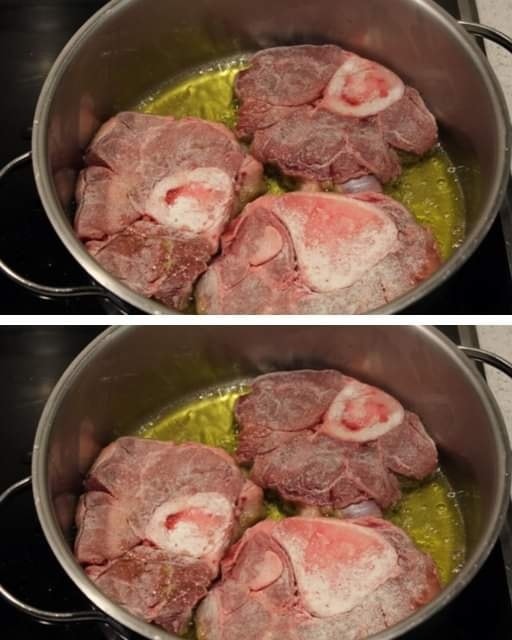ADVERTISEMENT
## Step-by-Step Guide to Grandma’s Osso Buco Recipe
Now that we’ve covered the key ingredients, let’s walk through the steps to create this delicious dish. Follow Grandma’s recipe to make sure you cook it to perfection!
### **Step 1: Preparing the Veal Shanks**
Start by patting the veal shanks dry with paper towels. This is important because you want a nice sear on the meat, which will help develop flavor. Season the shanks generously with salt and pepper on both sides.
### **Step 2: Searing the Veal Shanks**
In a large pot (preferably a heavy-bottomed Dutch oven or an enameled cast iron pot), heat the olive oil and butter over medium-high heat. Once the oil is hot and the butter has melted, carefully add the veal shanks to the pot. Sear the shanks on all sides until they are nicely browned. This will take about 5-7 minutes. Don’t rush this step—browning the meat is crucial for developing deep flavors.
### **Step 3: Sautéing the Vegetables**
Once the veal shanks are browned, remove them from the pot and set them aside. In the same pot, add the chopped onions, carrots, and celery. Sauté the vegetables for 5-7 minutes until they are softened and golden, scraping up any browned bits from the bottom of the pot (this is called “fond,” and it adds great flavor to the sauce).
Add the garlic and sauté for another minute, until fragrant.
### **Step 4: Adding Tomatoes, Wine, and Broth**
Next, add the diced tomatoes (or tomato paste if using) to the pot, stirring to combine with the vegetables. Pour in the white wine and let it simmer for about 2 minutes to cook off the alcohol. Afterward, add the broth, thyme, rosemary, and bay leaves. Stir everything together to combine.
### **Step 5: Cooking the Osso Buco**
Return the veal shanks to the pot, nestling them into the sauce. The liquid should come halfway up the sides of the meat. If there’s not enough liquid, add more broth or water. Bring the pot to a gentle simmer, then cover and reduce the heat to low.
Let the Osso Buco cook slowly for **2 to 3 hours**, or until the meat is fork-tender and falling off the bone. During this time, the flavors will meld together, and the marrow in the bones will begin to dissolve into the sauce, making it rich and velvety.
### **Step 6: Making the Gremolata**
While the Osso Buco is cooking, prepare the gremolata. Simply combine freshly chopped parsley, lemon zest, and minced garlic in a small bowl. Set aside.
### **Step 7: Serving the Osso Buco**
Once the meat is tender and the sauce is thickened, carefully remove the veal shanks from the pot and place them on a serving platter. Spoon the vegetables and sauce over the top of the meat. Sprinkle with the gremolata just before serving to add a burst of fresh, zesty flavor.
Osso Buco is typically served with **risotto alla Milanese** (saffron risotto) or polenta, but it also pairs beautifully with mashed potatoes or crusty bread to soak up the sauce.
—
## Variations of Osso Buco
While this recipe is the traditional version, Osso Buco has many regional variations that can be adjusted to suit different tastes and ingredients. Here are a few twists you might consider:
– **Osso Buco with Pork or Beef**: If veal isn’t available, pork or beef shanks can be used as a substitute. While veal is the classic choice, these meats also create a deliciously tender dish when slow-cooked.
– **Adding Mushrooms**: Some versions of Osso Buco include mushrooms for added earthiness. Simply add sliced mushrooms along with the vegetables.
– **Tomato Paste or Red Wine**: For a deeper, richer flavor, you can substitute the white wine with red wine or use tomato paste instead of fresh tomatoes.
—
## Conclusion
Osso Buco is a time-honored dish that has stood the test of time, from its humble origins in Lombardy to becoming a cherished family recipe. Grandma’s method of slow-cooking veal shanks in a rich sauce filled with vegetables, herbs, and wine brings a symphony of flavors to the table. With a sprinkle of gremolata on top, this dish becomes a complete meal, balancing rich, savory notes with a fresh, citrusy finish.
By following these steps and taking your time to cook the dish slowly, you’ll create a comforting, flavorful meal that your family will adore—just like Grandma used to make.
